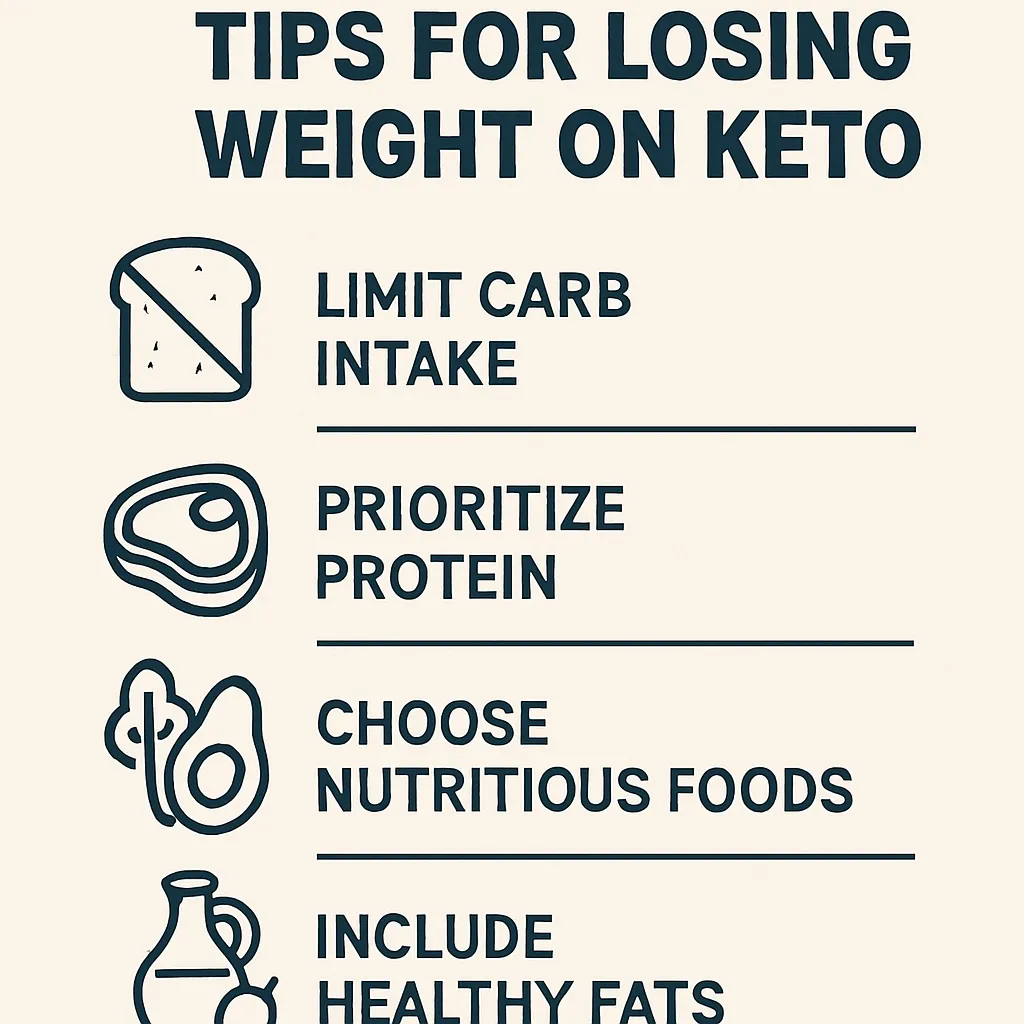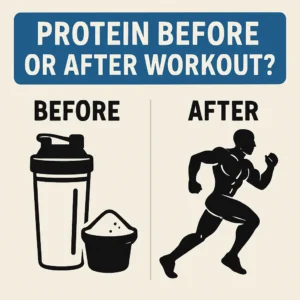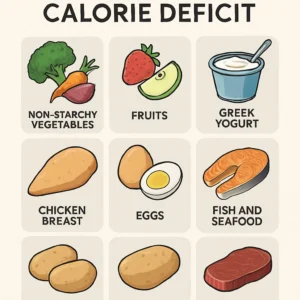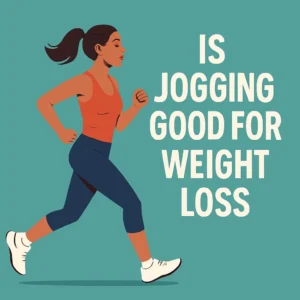The ketogenic diet has surged in popularity as an effective approach to losing weight on keto by shifting the body’s metabolism into fat-burning mode. In this article, we’ll dive deep into the science behind the keto diet, uncover common pitfalls, and provide practical tips for sustainable weight loss. You’ll learn how to choose the right foods, track macros and calories accurately, and overcome plateaus that can stall your progress. By understanding both the benefits and the risks of the ketogenic diet, you can craft a personalized keto meal plan that supports your goals. Whether you’re a newcomer to low-carb dieting or a seasoned keto veteran, these evidence-based strategies will help you stay on track and see real results.
Understanding the Keto Diet
What is the Keto Diet?
The keto diet is a very low-carb diet that drastically reduces carbohydrate intake and replaces it with healthy fats. This significant reduction in carbs puts your body into a metabolic state known as ketosis, in which fat, from your diet and from your body, is burned for energy. By following a ketogenic diet, you limit your carb intake to roughly 20–50 grams per day, depending on your individual needs. Protein is consumed at moderate levels, while fat becomes the primary macronutrient, making up about 70–75% of your total calories. This approach to eating has been used therapeutically for decades, particularly to treat epilepsy, but has gained traction for its impressive weight loss results. Understanding the basics of the keto diet is the first step toward effective and sustainable weight loss on keto.
When embarking on a ketogenic diet, it’s essential to focus on whole, unprocessed foods. Meat, fish, eggs, full-fat dairy, nuts, seeds, and non-starchy vegetables become staples in a keto-friendly meal plan. Many people mistakenly view the ketogenic diet as a fad or an excuse to eat endless bacon and cheese; however, nutrient balance is crucial for overall health. Hydration and electrolytes—namely sodium, potassium, and magnesium—must also be managed to prevent common side effects like headaches or muscle cramps. Ultimately, the keto diet emphasizes quality over quantity, encouraging you to choose nutrient-dense foods over processed alternatives.
How Does the Keto Diet Promote Weight Loss?
Weight loss on keto is largely driven by the body’s shift into ketosis, where fat becomes the primary fuel source instead of glucose. When carb intake is minimized, insulin levels drop, signaling the body to mobilize stored fat for energy. This process not only accelerates weight loss but also helps regulate appetite, often leading to a natural reduction in calorie intake without intentional restriction. Studies have shown that ketogenic diets can result in greater short-term weight loss compared to low-fat diets, partly due to improved satiety and metabolic efficiency.
Another mechanism behind keto weight loss involves water loss. Glycogen, the stored form of carbohydrates in your muscles and liver, binds to water. When glycogen stores are depleted on a ketogenic diet, significant water weight is shed in the initial phase. While this isn’t pure fat loss, it provides an early motivational boost. Over time, through sustained ketosis and careful management of carb intake and calorie intake, true fat loss continues at a steady pace. The combination of hormonal balance, appetite suppression, and metabolic shifts makes the ketogenic diet a powerful tool for losing weight on keto.
Common Mistakes When Following a Keto Diet

Consuming Too Many Carbs
One of the most frequent errors on a ketogenic diet is underestimating carb intake, which can prevent your body from entering or maintaining ketosis. Hidden carbs lurk in many everyday foods—spices, sauces, and even some vegetables. To avoid this pitfall, read labels meticulously and track every gram of carbs. Even a small slip-up, like an extra tablespoon of ketchup, can add up and stall your progress. Consistency is key: sticking to a strict carb limit each day ensures that your body remains in fat-burning mode and optimizes weight loss on the keto diet.
Another challenge is the fallacy that if a food is “low-carb,” it’s automatically keto-friendly. Products marketed as keto snacks often contain sugar alcohols or fillers that can spike blood sugar or disrupt ketosis. It’s better to rely on whole-food sources—avocados, olive oil, fatty fish, and leafy greens—than on processed “keto” alternatives. By focusing on real, nutrient-dense foods, you’ll minimize hidden carbs and maximize the health benefits of your low-carb diet.
Not Achieving Ketosis
Failing to reach or sustain ketosis is another common mistake many dieters make. Without ketosis, you won’t experience the full effects of the ketogenic diet, including efficient fat burning and appetite control. To monitor ketosis, many people use urine strips, blood meters, or breath analyzers. While these tools can be helpful, they must be used correctly and interpreted with context. For example, hydration levels and the timing of your last meal can influence readings, so consistency in testing conditions is crucial.
Entering ketosis typically takes 2–7 days of strict carb restriction, but factors like previous diet, activity level, and metabolic rate can influence this timeline. If you’re not seeing ketone results, re-evaluate your carb intake and ensure you’re not overlooking hidden sugars. Tracking your food meticulously using an app can reveal patterns that keep you out of ketosis. Making small adjustments—reducing an extra snack here or swapping a higher-carb vegetable there—can push your body over the threshold into sustained ketosis.
Inadequate Calorie Intake
While the ketogenic diet naturally suppresses appetite, some individuals eat too few calories, believing that simply cutting carbs is enough. Undereating can trigger metabolic adaptation, slow your resting metabolic rate, and ultimately hinder weight loss. It’s important to track your calorie intake and ensure you’re eating sufficient amounts to support your basal metabolic rate and physical activity. Using a reliable calorie-tracking app or consulting with a nutrition professional can help you strike the right balance.
Conversely, overconsumption of fats can also prevent weight loss, even on keto. While healthy fats are encouraged, they’re still calorically dense, and it’s possible to consume a surplus of calories if you’re not mindful. Strive for a moderate calorie deficit—typically 10–20% below maintenance—to promote steady, sustainable weight loss. Balancing fat intake with protein and low-carb vegetables helps you meet your nutritional needs without overloading on calories.
Tips for Successful Weight Loss on Keto
Before diving into specific tips, remember that losing weight on keto requires planning, consistency, and a willingness to adapt. A solid keto meal plan not only simplifies grocery shopping but also prevents accidental carb overload. Meal prepping your breakfasts, lunches, and snacks ensures you always have keto-friendly options on hand, reducing the temptation to stray.
- Choose Nutrient-Dense Foods: Fill your plate with leafy greens, fatty fish, eggs, nuts, seeds, and avocados. These foods provide essential vitamins and minerals while supporting ketosis and overall health. They also help you stay satisfied longer, reducing the urge to snack. Aim to include a variety of non-starchy vegetables to cover your micronutrient bases and support digestive health.
- Monitor Macros and Calories: Track your macronutrient ratios—typically 70–75% fat, 20–25% protein, and 5–10% carbs—and keep an eye on total calorie intake. Use a food diary or app to log every meal, snack, and condiment. Regular tracking helps identify patterns that may be hindering your progress, such as too much protein turning into glucose via gluconeogenesis.
- Incorporate Regular Exercise: While diet is the primary driver of weight loss, exercise enhances calorie burn, preserves lean muscle mass, and improves insulin sensitivity. Combine resistance training with moderate cardio to maximize results. Even daily walks after meals can support blood sugar control and help you maintain momentum on your keto diet journey.
Beyond these core strategies, consider intermittent fasting to further accelerate fat burning and simplify your eating schedule. Many people find that an 16:8 fasting window—16 hours of fasting followed by an 8-hour eating period—fits naturally with the keto lifestyle, enhancing ketosis and reducing hunger. Always listen to your body and adjust timing as needed to fit your routine.
Nutrient Comparison of Common Keto Foods
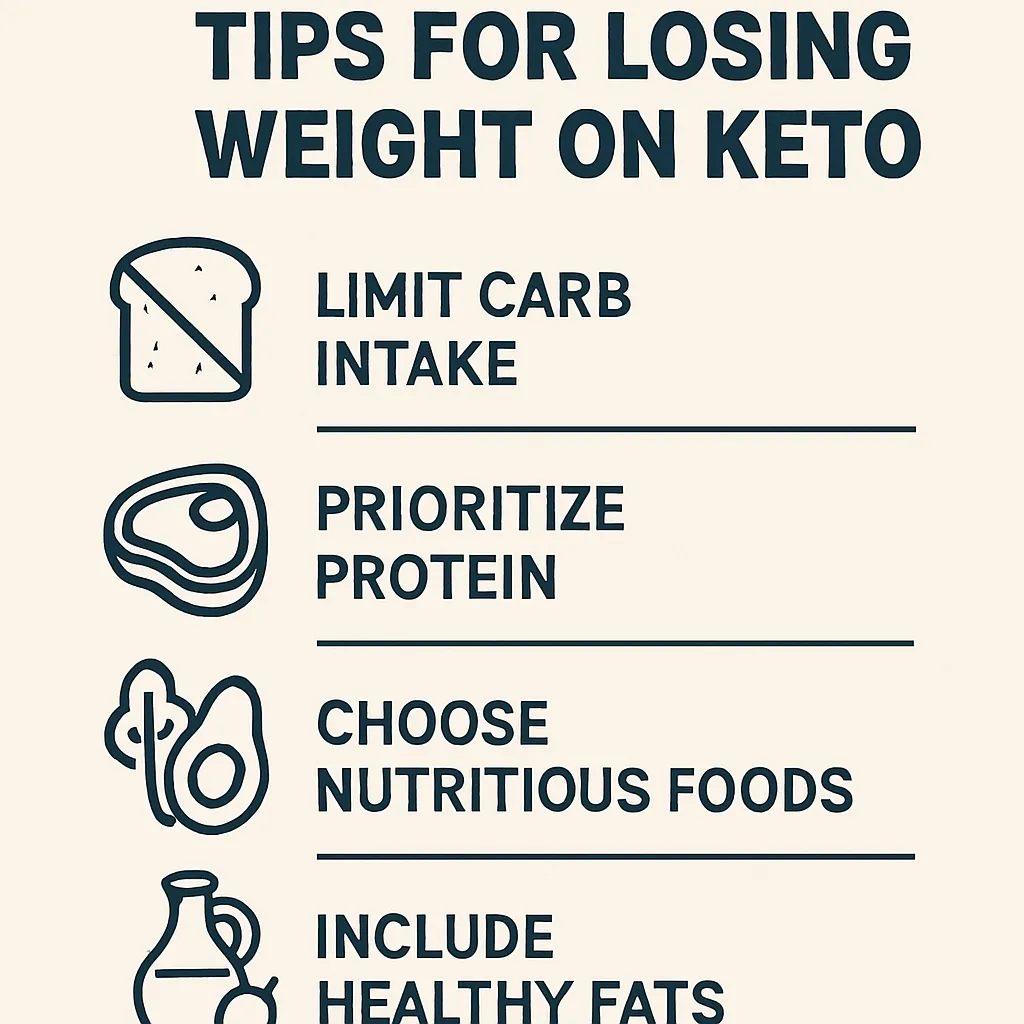
Below is a comparison table of macronutrient profiles for popular keto-friendly foods to help you plan meals and monitor your carb intake effectively.
| Food Item | Serving Size | Fat (g) | Protein (g) | Net Carbs (g) |
|---|---|---|---|---|
| Avocado | 100 g | 15 | 2 | 2 |
| Almonds | 30 g (?23 nuts) | 14 | 6 | 2 |
| Salmon | 100 g | 13 | 20 | 0 |
| Spinach | 100 g | 0.4 | 2.9 | 1 |
| Cheddar Cheese | 28 g (1 oz) | 9 | 7 | 0.4 |
Overcoming Weight Loss Plateaus
Adjusting Your Carb Intake
Plateaus are a normal part of any weight loss journey, including on keto. If you’ve stalled, it may be time to tweak your carb intake—either by reducing it further or cycling carbs strategically. Some individuals benefit from a “lazy keto” approach for a time and then need to recommit to stricter carb limits to break through a plateau. Identifying hidden carbs in sauces, nuts, or dairy products is often enough to jumpstart fat loss again.
Another approach is targeted keto, where you add small amounts of carbs before or after workouts to fuel performance without derailing ketosis. This method can support more intense exercise sessions and help maintain muscle mass, which in turn boosts your resting metabolic rate. Experiment with timing and quantity—typically 10–20 grams of fast-digesting carbs—to find what works best for your body and goals.
Evaluating Hidden Carbs
Even seasoned keto dieters can overlook sneaky sources of sugar and starch. Hidden carbs hide in salad dressings, protein powders, and even certain spices. When tracking your carb intake, scrutinize ingredient lists for maltodextrin, dextrose, and other additives that count toward your daily limit. Shopping for whole, unprocessed foods and making dressings and sauces at home ensures transparency in every bite.
Keeping a carb log for a week—detailing every meal and snack—can reveal patterns and problem areas. You might discover that low-carb tortillas or “keto-friendly” bars are the culprits knocking you out of ketosis. By eliminating or substituting these items, you can restore effective carb control and overcome your keto weight loss plateau.
Managing Stress and Sleep
Stress and poor sleep are often underestimated contributors to weight loss plateaus. High stress elevates cortisol levels, which can promote fat storage and increase hunger. Similarly, inadequate sleep disrupts appetite-regulating hormones like leptin and ghrelin, leading to overeating. Prioritizing stress management techniques—such as meditation, yoga, or deep breathing—can support hormonal balance and weight loss.
Establishing a consistent sleep schedule, minimizing screen time before bed, and creating a restful environment can significantly improve sleep quality. Aim for 7–9 hours of uninterrupted rest per night to optimize recovery and metabolic health. Addressing these lifestyle factors can be the missing link to finally breaking through a stubborn plateau on your keto journey.
Keto Diet Risks and Considerations

Potential Side Effects
The transition to a ketogenic diet can come with temporary side effects known as the “keto flu,” including headache, fatigue, dizziness, nausea, and irritability. These symptoms arise as your body adapts to burning fat instead of glucose. Increasing electrolyte intake—through salt, potassium-rich foods, and magnesium supplements—can alleviate many of these issues. Staying hydrated is also essential to minimize discomfort during the initial phase of ketosis.
Longer-term side effects may include constipation due to lower fiber intake, changes in lipid profiles, and nutrient deficiencies if food variety is insufficient. To mitigate these risks, prioritize non-starchy vegetables, nuts, seeds, and quality protein sources. Regular blood work can help monitor cholesterol levels, kidney function, and nutrient status, ensuring that your ketogenic diet remains safe and effective.
Long-term Health Implications
While the ketogenic diet can offer rapid weight loss and improved blood sugar control, its long-term health implications are still being studied. Some research suggests potential benefits for neurological conditions, while other studies raise concerns about sustained high saturated fat intake. It’s important to differentiate between healthy fats—like those from olive oil, avocados, and fatty fish—and less favorable sources such as processed meats and hydrogenated oils.
Before embarking on a long-term ketogenic diet, consult with a healthcare professional, especially if you have pre-existing conditions like diabetes, cardiovascular disease, or kidney issues. Periodic re-evaluation and dietary adjustments can help balance the benefits of sustained ketosis with overall nutritional needs and health risks.
Conclusion
Recap of Effective Strategies for Keto Weight Loss
In summary, losing weight on keto involves more than just cutting carbs—it requires careful planning, consistent tracking of macros and calorie intake, and attention to overall health. By understanding how the ketogenic diet works and avoiding common mistakes like hidden carbs and inadequate calories, you set the stage for success. Incorporating nutrient-dense foods and regular exercise further supports fat loss and metabolic health. When plateaus arise, adjusting carb intake, evaluating hidden sugars, and managing stress and sleep can help you push past sticking points. Finally, remain aware of potential side effects and long-term health considerations, seeking professional guidance as needed. With these evidence-based tips and strategies, you’ll be well-equipped to achieve sustainable weight loss and thrive on the keto diet.
Ready to start your keto journey or overcome your current challenges? Share your experiences and questions in the comments below—let’s support each other on the path to better health and effective weight loss on keto!
